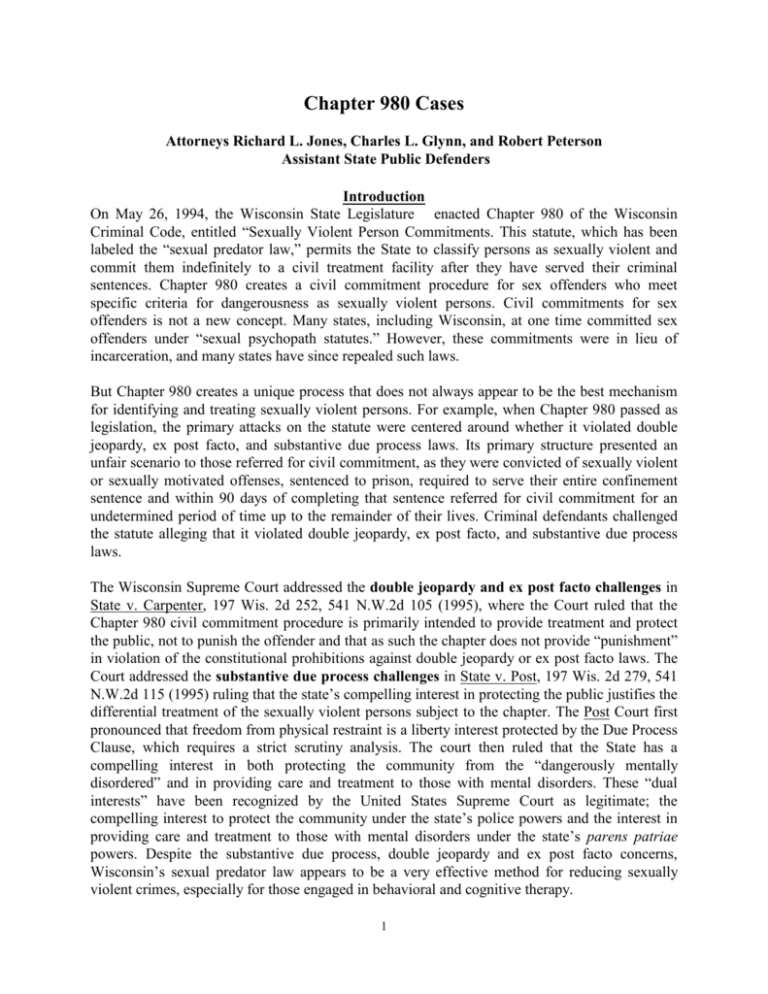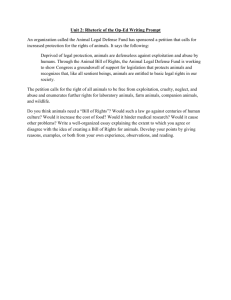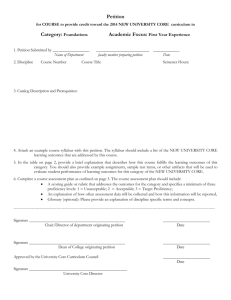
Chapter 980 Cases
Attorneys Richard L. Jones, Charles L. Glynn, and Robert Peterson
Assistant State Public Defenders
Introduction
On May 26, 1994, the Wisconsin State Legislature enacted Chapter 980 of the Wisconsin
Criminal Code, entitled “Sexually Violent Person Commitments. This statute, which has been
labeled the “sexual predator law,” permits the State to classify persons as sexually violent and
commit them indefinitely to a civil treatment facility after they have served their criminal
sentences. Chapter 980 creates a civil commitment procedure for sex offenders who meet
specific criteria for dangerousness as sexually violent persons. Civil commitments for sex
offenders is not a new concept. Many states, including Wisconsin, at one time committed sex
offenders under “sexual psychopath statutes.” However, these commitments were in lieu of
incarceration, and many states have since repealed such laws.
But Chapter 980 creates a unique process that does not always appear to be the best mechanism
for identifying and treating sexually violent persons. For example, when Chapter 980 passed as
legislation, the primary attacks on the statute were centered around whether it violated double
jeopardy, ex post facto, and substantive due process laws. Its primary structure presented an
unfair scenario to those referred for civil commitment, as they were convicted of sexually violent
or sexually motivated offenses, sentenced to prison, required to serve their entire confinement
sentence and within 90 days of completing that sentence referred for civil commitment for an
undetermined period of time up to the remainder of their lives. Criminal defendants challenged
the statute alleging that it violated double jeopardy, ex post facto, and substantive due process
laws.
The Wisconsin Supreme Court addressed the double jeopardy and ex post facto challenges in
State v. Carpenter, 197 Wis. 2d 252, 541 N.W.2d 105 (1995), where the Court ruled that the
Chapter 980 civil commitment procedure is primarily intended to provide treatment and protect
the public, not to punish the offender and that as such the chapter does not provide “punishment”
in violation of the constitutional prohibitions against double jeopardy or ex post facto laws. The
Court addressed the substantive due process challenges in State v. Post, 197 Wis. 2d 279, 541
N.W.2d 115 (1995) ruling that the state’s compelling interest in protecting the public justifies the
differential treatment of the sexually violent persons subject to the chapter. The Post Court first
pronounced that freedom from physical restraint is a liberty interest protected by the Due Process
Clause, which requires a strict scrutiny analysis. The court then ruled that the State has a
compelling interest in both protecting the community from the “dangerously mentally
disordered” and in providing care and treatment to those with mental disorders. These “dual
interests” have been recognized by the United States Supreme Court as legitimate; the
compelling interest to protect the community under the state’s police powers and the interest in
providing care and treatment to those with mental disorders under the state’s parens patriae
powers. Despite the substantive due process, double jeopardy and ex post facto concerns,
Wisconsin’s sexual predator law appears to be a very effective method for reducing sexually
violent crimes, especially for those engaged in behavioral and cognitive therapy.
1
Summary of the Civil Commitment Procedure Under Chapter 980
The Wisconsin Supreme Court summarized the procedure under Chapter 980, in In re
Commitment of Arends, 2010 WI 46, 325 Wis. 2d 1, 784 N.W.2d 513, as follows:
If the State wishes to commit a [person as a] sexually violent offender, it must file a
petition alleging that the person is a “sexually violent person.” At trial, the State has the
burden of proving, beyond a reasonable doubt, that the person: (1) has been adjudicated to
have committed a sexually violent offense; (2) has a mental disorder that predisposes the
person to acts of sexual violence; and (3) is more likely than not to commit another
violent sexual offense. See Wis. Stat. §§ 980.01(7), 980.02(2), 980.05(3)(a). If the trier of
fact so finds, the court must commit the person to the custody of the Department, which
in turn must place the person into institutional care until the person is no longer a sexually
violent person. Wis. Stat. § 980.06.
A committed person must be re-examined by a mental health professional “at least once
each 12 months,” at which time the person has the right to also be examined by an
independent examiner. Wis. Stat. § 980.07(1). A committed person wishing to secure his
or her release has two options. The person may file a petition for supervised release,
which he or she may do no more frequently than every 12 months. Wis. Stat. § 980.08.
Alternatively, a committed person may file a petition for discharge, which he or she may
do at any time. Wis. Stat. § 980.09(1).
Initiation of 980 Proceedings
Department of Corrections (DOC) inmates approaching release from prison sentences being
served for a 980-qualifying offense (after Act 434 this is virtually every sex-related felony) are
referred to the End of Confinement Review Board (ECRB). The ECRB reviews these particular
offenders to determine if they might meet the criteria for commitment as a sexually violent
person. If the ECRB determines that an offender might meet the criteria for commitment as a
sexually violent person, they are referred for further evaluation and action. The ERCB actually
recommends 980 action on approximately one-third of those reviewed (approximately 180).
Those persons considered for further evaluation and action are referred to the DOC Evaluation
Team (a group of DOC staff psychologists), which evaluate offenders to determine if they should
be recommended for commitment as sexually violent persons. A DOC Staff Psychologist is
assigned to evaluate each offender referred to the Team and must generate a Special Purpose
Evaluation (SPE) Report which recommends immediate discharge or commitment as a sexually
violent person. If the evaluated offender does not meet the criteria for commitment as a sexually
violent person, he is released according to the terms of his original sentence. If the offender
meets the criteria for commitment, either the Attorney General or the District Attorney in the
county of residence, county of confinement, or county of conviction for a sexually violent offense
then files a 980 petition. Commitment is recommended for approximately 45 of those referred. A
petition filed under section 980.02 shall state with particularity essential facts to establish
probable cause to believe the person is a sexually violent person. The petition shall state the
grounds on which the offense or act is alleged to be sexually motivated. If the petition filed meets
the statutory requirements, a probable cause hearing must be held.
2
Probable Cause Hearing
Whenever a petition is filed under s. 980.02, the court shall hold a hearing to determine whether
there is probable cause to believe that the person named in the petition is a sexually violent
person. If the court determines after a hearing that there is probable cause to believe that the
person named in the petition is a sexually violent person, the court shall order that the person be
taken into custody if he or she is not in custody and shall order the person to be transferred within
a reasonable time to an appropriate facility specified by the department for an evaluation by the
department as to whether the person is a sexually violent person. If the court determines that
probable cause does not exist to believe that the person is a sexually violent person, the court
shall dismiss the petition.
A “sexually violent person” is a person who has been convicted of a sexually violent offense,
has been adjudicated delinquent for a sexually violent offense, or has been found not guilty of or
not responsible for a sexually violent offense by reason of insanity or mental disease, defect, or
illness, and who is dangerous to others because he or she currently has a mental disorder that
makes it more likely than not that the person will engage in future acts of sexual violence. “
The person subject to a 980 petition has certain rights, including the right to counsel, remain
silent, present and cross-examine witnesses, have hearings recorded by a court reporter, a jury
trial, to have certain materials disclosed as discovery (980.036), and to have an examiner
appointed at county expense to determine if they person is indeed a sexually violent person.
Original Commitment Trial
Once probable cause is found, and if the person subject to the 980 petition denies the facts
alleged in the petition, the court shall, upon the person's request, appoint a qualified and
available licensed physician, licensed psychologist, or other mental health professional to
perform an examination of the person's mental condition and participate on the person's behalf in
a trial or other proceeding under this chapter at which testimony is authorized.
Upon the order of the circuit court, the county shall pay, as part of the costs of the action, the
costs of the examiner. It is important to note that the state may also retain a licensed physician,
licensed psychologist, or other mental health professional to examine the mental condition of a
person who is the subject of a petition under s. 980.02 or who has been committed under s.
980.06 and to testify at trial or at any other proceeding under this chapter at which testimony is
authorized.
The examination, evaluation and reports prepared by the experts form the foundation for the
state’s assertion that the person is a sexually violent person and the respondent’s defense and
argument that they are not. The matter then proceeds to trial, which may be either a court or jury
trial. Any party may request that the matter be tried before a jury of 12 persons as opposed to the
court.
At a trial on a petition under Chapter 980, the petitioner (state) has the burden of proving beyond
a reasonable doubt that the person who is the subject of the petition is a sexually violent person.
3
That standard requires them to prove the following three (3) elements:
1.
The Person Has Been Convicted of a Sexually Violent Offense. The person has been
convicted of, found delinquent for, or found not guilty by reason of a mental disease or
defect of a sexually violent offense, or sexually motivated offense.
2.
The Person Currently has a Mental Disorder. “Mental disorder” is defined in
980.01(2) as a congenital or acquired condition affecting the emotional or volitional
capacity that predisposes a person to engage in acts of sexual violence. “Mental Disorder”
is defined in WI Jury Instruction 2502 as a condition affecting the emotional or volitional
capacity that predisposes a person to engage in acts of sexual violence and causes serious
difficulty in controlling behavior. Only those mental disorders that predispose a person to
engage in acts of sexual violence and cause serious difficulty in controlling behavior are
sufficient for purposes of commitment as a sexually violent person.
3.
The Person is Dangerous to Others Because He/She Has a Mental Disorder Which
Makes It More Likely Than Not That He/She Will Engage in One or More Future
Acts of Sexual Violence. The person's mental disorder makes it likely that he or she will
engage in acts of sexual violence. The person is more likely than not to commit such acts
of sexual violence. “Acts of sexual violence” means conduct that constitutes the
commission of a sexually violent offense. [980.01(1b)]. “Likely” means more likely than
not. [980.01(1m)]. “More likely than not” as used in sub. (1m) is not an obscure or
specialized term of art, but a commonly-used expression. State v. Smalley, 2007 WI App
219, 305 Wis. 2d 709, 741 N.W.2d 286 (2007). “Acts of sexual violence” means acts
which would constitute “sexually violent offenses.” [980.01(7)]. State v. Smalley, 2007
WI App 219, 305 Wis. 2d 709, 741 N.W.2d 286 (2007).
If the court or jury determines that the person who is the subject of a petition under s. 980.02 is a
sexually violent person, the court shall enter a judgment on that finding and shall commit the
person as provided under s. 980.06. If the court or jury is not satisfied beyond a reasonable doubt
that the person is a sexually violent person, the court shall dismiss the petition and direct that the
person be released unless he or she is under some other lawful restriction.
Commitment
Section 980.06 provides that if a court or jury determines that the person who is the subject of a
petition under s. 980.02 is a sexually violent person, the court shall order the person to be
committed to the custody of the department for control, care and treatment until such time as the
person is no longer a sexually violent person. A commitment order under this section shall
specify that the person be placed in institutional care.
Periodic Reexaminations and Annual Reviews
Once a person has been committed under 980.02, that person is entitled to annual reviews to
determine if they have made sufficient progress in treatment to be considered for either discharge
from that commitment or release from the institution on supervised release. The first step in this
process is the periodic reexamination and preparation of the annual treatment progress report.
4
980.07 provides that if a person is committed under s. 980.06 and has not been discharged
under s. 980.09(4), the department shall appoint an examiner to conduct a reexamination of the
person's mental condition within 12 months after the date of the initial commitment order
under s. 980.06 and again thereafter at least once each 12 months to determine whether the
person has made sufficient progress for the court to consider whether the person should be placed
on supervised release or discharged. The examiner shall apply the criteria under s.
980.08(4)(cg) when considering if the person should be placed on supervised release and shall
apply the criteria under s. 980.09(3) when considering if the person should be discharged. At the
time of a reexamination under this section, the court shall appoint an examiner as provided
under s. 980.031(3) upon request of the committed person or the person may retain an examiner.
The county shall pay the costs of an examiner appointed by the court as provided under s.
51.20(18)(a).
At any reexamination, the treating professional shall prepare a treatment progress report. The
treatment progress report shall consider all of the following: (1) The specific factors associated
with the person's risk for committing another sexually violent offense; (2) Whether the person is
making significant progress in treatment or has refused treatment; (3) The ongoing treatment
needs of the person, and (4) Any specialized needs or conditions associated with the person that
must be considered in future treatment planning. The department shall submit an annual report
comprised of the reexamination report and the treatment progress report to the court that
committed the person under s. 980.06, the person committed under s. 980.06, the department of
justice, and the district attorney, and a copy of the annual report shall be placed in the person's
treatment records.
Petitions for Discharge and Supervised Release
If the annual review and treatment progress report favor and/or recommend discharge, supervised
release, or both, the committed person will file either a Petition for Discharge or a Petition for
Supervised Release. Either way, the committed person will seek the appointment of an examiner
to prepare a report that they hope will recommend discharge, supervised release, or both.
The right to petition for discharge or supervised release is “among the protections that the
Supreme Court has considered significant in concluding that [Chapter 980] does not violate the
equal protection clause or the right to due process.” State v. Combs, 2006 WI App 137 ¶28, 295
Wis. 2d 457, 720 N.W.2d 684 (citing State v. Post, 197 Wis. 2d 279, 307 n. 14, 313-16, 325-327,
541 N.W.2d 115 (1995). As noted by the United States and Wisconsin Supreme Courts, “[c]ivil
commitment for any purpose constitutes a significant deprivation of liberty that requires due
process protection.” State v. Post, 197 Wis. 2d 279, 302, 541 N.W.2d 115, 122 (1995). Since its
enactment, chapter 980 has been construed as offering “ample and fair opportunity for review
and petition for release.” Id.
The right to periodic reexaminations and the ability to petition for discharge and/or supervised
release are among the protections that the Wisconsin Supreme Court has considered significant
in concluding that chapter 980 does not violate the equal protection clause or the right to due
process. In re the Commitment of Combs, 2006 WI App 137 ¶28, 298 Wis. 2d 457, 476, 720
5
N.W.2d 684, 693 (2006) (citing State v. Post, 197 Wis. 2d 279, 307 n. 14, 313-16, 325-327, 541
N.W.2d 115 (1995)). Although the state is not required to provide unlimited opportunities for
review, it must allow for review when adequate cause is shown. See State v. Post, 197 Wis. 2d
279, 327, 541 N.W.2d 115 (1995). Thus, whenever the committed person has reason to believe
that he/she no longer meets the criteria for commitment as a sexually violent person, they may
petition the court for discharge.
The Discharge Process
The discharge process is outlined in Wis. Stat. §980.09. The court, pursuant to §980.02 and
§980.09(2), is required to conduct a two-step review process to determine whether the committed
person is entitled to a trial. Wis. Stat. §980.09(1) provides that “a committed person may petition
the committing court for discharge at any time. The court shall deny the petition under this
section without a hearing unless the petition alleges facts from which the court or
jury would likely conclude the person's condition has changed since the most recent order
denying a petition for discharge after a hearing on the merits, or since the date of his or her initial
commitment order if the person has never received a hearing on the merits of a discharge
petition, so that the person no longer meets the criteria for commitment as a sexually violent
person.” Wis. Stat. §980.09(2) provides that “…if the court determines that the record does not
contain facts from which a court or jury would likely conclude that the person no longer
meets the criteria for commitment, the court shall deny the petition [but] if the court determines
that the record contains facts from which a court or jury would likely conclude the
person no longer meets the criteria for commitment, the court shall set the matter for trial.”
The Wisconsin Supreme Court clarified the discharge procedure outlined in Wis. Stat.
§980.09(1) and (2) in In re Commitment of Arends, 2010 WI 46, 325 Wis. 2d 1, 784 N.W.2d 513.
According to the court in Arends, the first step, pursuant to §980.09(1), is a “paper review of the
petition and its attachments only.” Arends at ¶25. The court noted that “[t]he clear purpose of
such a review is to weed out meritless and unsupported petitions.” Id. The court explains “[t]his
standard is similar to that used in civil cases to decide a motion to dismiss for failure to state a
claim upon which relief can be granted under Wis. Stat. §802.06(2)(a)(6) (2005-2006).” Id. The
second step is a more expansive review that takes into account the total record to “determine
whether the documents and arguments before the court contain ‘facts from which the court or
jury may conclude that the person does not meet the criteria for commitment.’” Arends at ¶37.
One of the primary purposes of the review process is to weed out meritless petitions and/or
petitions that seek to simply litigate what has previously been litigated. See State v. Arends, 2010
WI 46, 325 Wis. 2d 1, 22, 784 N.W.2d 515.
The Legal Standard for Discharge/Supervised Release
To remain committed as a sexually violent person, the person must be “dangerous to others
because the person’s mental disorder makes it likely that he or she will engage in acts of sexual
violence.” Wis. Stat. §980.02(2)(c). In chapter 980, “mental disorder” is defined in §980.01(2) as
“a congenital or acquired condition affecting the emotional or volitional capacity that predisposes
a person to engage in acts of sexual violence.”
6
“Likely,” in this context, is defined in §980.01(1m), Wis. Stats., as “more likely than not.” See
also State v. Smalley, 2007 WI App 219, 305 Wis. 2d 709, 741 N.W.2d 709, 741 N.W.2d 286
which articulates that the term “’more likely than not’ is not an obscure or specialized term of art,
but a commonly-used expression.” The Smalley court went on to clarify that “it is hard to think
of a clearer definition of the term than the term itself; although perhaps its expression to ‘more
likely to happen than not to happen’ is more explicit.” Id.
The requirement of the person petitioning for discharge is to show that they are no longer a
sexually violent person. The court in State v. Combs, 2006 WI App 137, 295 Wis. 2d 457, 720
N.W.2d 684 (citing State v. Pocan, 2003 WI App 233 ¶8, 267 Wis. 2d 953, 671 N.W.2d 860),
indicated that, though it is not the only way, progress in treatment is one way to show that a
person is no longer a sexually violent person. The Combs court further articulated that the
determination that a person is no longer sexually violent “may [also] be established by a method
professionals use to evaluate whether a person is sexually violent that was not available at the
time of the prior examination, as well as by a change in the person himself or herself.” Combs at
¶25.
Petitions for Supervised Release
Any person who is committed under s. 980.06 may petition the committing court to modify its
order by authorizing supervised release if at least 12 months have elapsed since the initial
commitment order was entered or at least 12 months have elapsed since the most recent release
petition was denied, since supervised release was denied under s. 980.09(4), or since the most
recent order for supervised release was revoked. The director of the facility at which the person is
placed may file a petition under this subsection on the person's behalf at any time.
The person submitting the petition may use experts or professional persons to support his or her
petition. The district attorney or the department of justice may use experts or professional
persons to support or oppose any petition.
The court, without a jury, shall hear the petition within 120 days after the report of the courtappointed examiner appointed is filed with the court, unless the court for good cause extends this
time limit.
In making a decision, the court may consider, without limitation because of enumeration, the
nature and circumstances of the behavior that was the basis of the allegation in the petition, the
person's mental history and present mental condition, where the person will live, how the person
will support himself or herself, and what arrangements are available to ensure that the person has
access to and will participate in necessary treatment, including pharmacological treatment using
an antiandrogen or the chemical equivalent of an antiandrogen if the person is a serious child sex
offender. A decision on a petition filed by a person who is a serious child sex offender may not
be made based on the fact that the person is a proper subject for pharmacological treatment using
an antiandrogen or the chemical equivalent of an antiandrogen or on the fact that the person is
willing to participate in pharmacological treatment using an antiandrogen or the chemical
equivalent of an antiandrogen.
7
The court may not authorize supervised release unless, based on all of the reports, trial records,
and evidence presented, the court finds that all of the following criteria are met:
1.
The person is making significant progress in treatment and the person's progress can be
sustained while on supervised release
2.
It is substantially probable that the person will not engage in an act of sexual violence
while on supervised release.
3.
Treatment that meets the person's needs and a qualified provider of the treatment are
reasonably available.
4.
The person can be reasonably expected to comply with his or her treatment requirements
and with all of his or her conditions or rules of supervised release that are imposed by the
court or by the department.
5.
A reasonable level of resources can provide for the level of residential placement,
supervision, and ongoing treatment needs that are required for the safe management of the
person while on supervised release.
The person has the burden of proving by clear and convincing evidence that the person meets the
criteria outlined above.
If the court finds that all of the criteria are met, the court shall select a county to prepare a report.
Unless the court has good cause to select another county, the court shall select the person's
county of residence as determined by the department under s. 980.105.
The court shall order the county department under s. 51.42 in the county of intended placement to
prepare a report, either independently or with the department of health services, identifying
prospective residential options for community placement.
The court shall review the plan submitted by the department under par. (cm). If the details of the
plan adequately meet the treatment needs of the individual and the safety needs of the
community, then the court shall approve the plan and determine that supervised release is
appropriate. If the details of the plan do not adequately meet the treatment needs of the individual
or the safety needs of the community, then the court shall determine that supervised release is not
appropriate or direct the preparation of another supervised release plan to be considered by the
court under this paragraph.
An order for supervised release places the person in the custody and control of the department.
The department shall arrange for control, care and treatment of the person in the least restrictive
manner consistent with the requirements of the person and in accordance with the plan for
supervised release approved by the court. A person on supervised release is subject to the
conditions set by the court and to the rules of the department.
8
As a condition of supervised release granted under this chapter, for the first year of supervised
release, the court shall restrict the person on supervised release to the person's residence except
for outings approved by the department of health services that are under the direct supervision of
a department of corrections escort and that are for employment or volunteer purposes, religious
purposes, educational purposes, treatment and exercise purposes, supervision purposes, or
residence maintenance, or for caring for the person's basic living needs.
If the department believes that a person on supervised release, or awaiting placement on
supervised release, has violated, or threatened to violate, any condition or rule of supervised
release, the department may petition for revocation of the order granting supervised release as or
may detain the person. If the department believes that a person on supervised release, or awaiting
placement on supervised release, is a threat to the safety of others, the department shall detain the
person and petition for revocation of the order granting supervised release. If the department
concludes that the order granting supervised release should be revoked, it shall file with the
committing court a statement alleging the violation and or threat of a violation and a petition to
revoke the order for supervised release. The court shall hear the petition within 30 days, unless
the hearing or time deadline is waived by the detained person. A final decision on the petition to
revoke the order for supervised release shall be made within 90 days of the filing. Pending the
revocation hearing, the department may detain the person in the county jail or return him or her
to institutional care. If the court finds after a hearing, by clear and convincing evidence, that any
rule or condition of release has been violated and the court finds that the violation of the rule or
condition merits the revocation of the order granting supervised release, the court may revoke the
order for supervised release and order that the person be placed in institutional care. The court
may consider alternatives to revocation. The person shall remain in institutional care until the
person is discharged from the commitment under s. 980.09 or is placed again on supervised
release. If the court finds after a hearing, by clear and convincing evidence, that the safety of
others requires that supervised release be revoked the court shall revoke the order for supervised
release and order that the person be placed in institutional care. The person shall remain in
institutional care until the person is discharged from the commitment under s. 980.09 or is placed
on supervised release.
Petitions for Discharge
A committed person may petition the committing court for discharge at any time. The court shall
deny the petition under this section without a hearing unless the petition alleges facts from which
the court or jury would likely conclude the person's condition has changed since the most recent
order denying a petition for discharge after a hearing on the merits, or since the date of his or her
initial commitment order if the person has never received a hearing on the merits of a discharge
petition, so that the person no longer meets the criteria for commitment as a sexually violent
person.
If a person files a petition for discharge, the person may use experts or professional persons to
support his or her petition. The district attorney or the department of justice may use experts or
professional persons to support or oppose any petition.
9
In reviewing the petition, the court may hold a hearing to determine if the person's condition has
sufficiently changed such that a court or jury would likely conclude the person no longer
meets the criteria for commitment as a sexually violent person. In determining under this
subsection whether the person's condition has sufficiently changed such that a court or jury
would likely conclude that the person no longer meets the criteria for commitment, the
court may consider the record, including evidence introduced at the initial commitment trial or
the most recent trial on a petition for discharge, any current or past reports filed under s. 980.07,
relevant facts in the petition and in the state's written response, arguments of counsel, and any
supporting documentation provided by the person or the state. If the court determines that
the record does not contain facts from which a court or jury would likely conclude that the
person no longer meets the criteria for commitment, the court shall deny the petition. If the court
determines that the record contains facts from which a court or jury would likely conclude the
person no longer meets the criteria for commitment, the court shall set the matter for trial.
At trial, the state has the burden of proving by clear and convincing evidence that the person
meets the criteria for commitment as a sexually violent person. If the court or jury is satisfied that
the state has not met its burden of proof, the person shall be discharged from the custody of the
department. If the court or jury is satisfied that the state has met its burden of proof, the
court shall proceed to determine whether to modify the person's existing commitment order by
authorizing supervised release, unless the person waives consideration of the criteria. If the
person waives consideration of these criteria, the waiver is a denial of supervised release.
Procedures for Discharge Hearings
The district attorney or the department of justice, whichever filed the original petition, or
the person who filed the petition for discharge or his or her attorney may request that
a trial under s. 980.09(3) be to a jury of 6. A jury trial is deemed waived unless it is demanded
within 10 days of the determination by the court that a court or jury would likely conclude
under s. 980.09(1) that the person's condition has sufficiently changed. No verdict shall be valid
or received unless at least 5 of the jurors agree to it.
10








